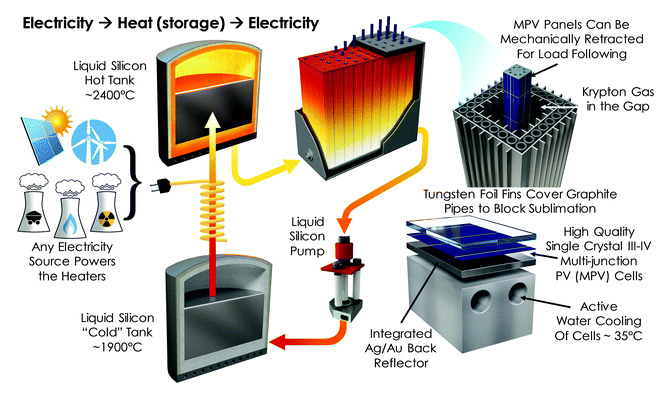![]()
Researchers at MIT and Georgia Tech have proposed a system that would store solar and wind energy in the form of white-hot liquid silicon, stored in heavily insulated tanks. [Image: Duncan MacGruer]
One of the biggest hurdles to mass rollout of renewable energy, such as solar and wind power, is finding cost-effective ways to store it, so that the energy is still available when the sun isn’t shining or the wind isn’t blowing. Now, a U.S.-based engineering team has come up with a counterintuitive solution: store the harvested solar or wind energy as heat in white-hot molten silicon—and re-harvest the stored energy as electricity on demand using multi-junction photovoltaics (Energy Environ. Sci., doi: 10.1039/c8ee02341g).
The team’s calculations suggest that its design could prove significantly cheaper than the alternatives for grid-scale storage of renewable energy being floated right now. And the researchers estimate that a single installation of their designed system could pack enough power-storage capacity to allow a city of roughly 100,000 homes to run entirely on renewable energy around the clock.
The energy-storage problem
Among the options commonly discussed for renewable-energy storage are lithium-ion batteries and pumped hydroelectric storage (essentially, using renewable energy to pump water into a reservoir, which then drives a hydroelectric turbine). But while lithium-ion battery prices have fallen rapidly, they remain a very expensive way to store energy. Pumped hydroelectric storage is cheaper, but it tends to be geographically limited and not suitable for rolling out on a mass scale.
As a result, most existing solar and wind power systems need to be backed up by fossil-fuel-driven turbines to provide power when the renewable source isn’t available (for example, for solar energy, once the sun has set). And several studies have estimated that, without a cost-effective mode of grid-level storage, grid penetration of energy from renewable sources won’t get much past 10 to 15 percent.
From molten salt to molten silicon
The team behind the new research, led by Asegun Henry of the Massachusetts Institute of Technology (MIT) and the Georgia Institute of Technology (Georgia Tech), wanted to see if they could come up with a more cost-effective alternative. To start with, they took inspiration from concentrated solar power (CSP) plants—large facilities that use mirrors and optics to concentrate solar energy and convert it to heat, which is stored in molten salt at temperatures on the order of 550 °C. The hot salt can then be pumped through a heat exchanger, turned into steam, and used to run a steam turbine.
CSPs are an established technology—but also still a relatively expensive one for storing solar energy. And schemes that store energy as heat and convert it to electricity face a fundamental stumbling block: thermodynamically, converting the heat back to electricity, especially through vehicles such as a steam turbine, is very inefficient. “The thinking,” Henry noted in a press release accompanying the work, “has been that the cost [of the CSP technology] will never get low enough to compete with natural gas.”
To make heat storage more cost-effective, the MIT–Georgia Tech team looked at a completely different architecture. The proposed system would start not with molten salt, but with molten silicon, which can be stored at much higher temperatures, on the order of 2400 °C. And it uses both a different method both to convert harvested solar energy into stored heat, and a different method to re-convert the stored heat back to electricity.
Storing and harvesting
In the proposed scheme, molten silicon in a 10-m-wide “cold” reservoir—a graphite tank maintained at a mere 1900 °C—is pumped through a series of pipes that pass through tungsten or graphite heaters. Those heaters draw electricity (such as solar-generated electricity from a nearby town) from the grid, and convert it to heat through joule heating. Passage through the pipes raises the temperature of the silicon to a blistering 2400 °C; this white-hot stuff is stored in another graphite tank, the “hot” reservoir.

A schematic overview of the proposed design for storing and re-harvesting solar energy. [Image: C. Amy et al., Energy Environ. Sci., doi: 10.1039/C8EE02341G (CC-BY-NC 3.0)]
When the sun goes down and the town still needs electricity, the hot molten silicon passes through another set of graphite tubes covered with tungsten foil, which—much like the filament in an incandescent bulb—glows and emit photons as the molten silicon cools and gives off its heat. Those photons are captured and converted by multi-junction photovoltaic cells to electricity, which is sent back to the town. The cooled molten silicon, meanwhile, returns to the cold reservoir for the next cycle.
Next step: A prototype
Thus far, the scheme exists mainly in computer models and calculations (though the team has done some feasibility studies to prove out the ability of the proposed materials to handle the high temperatures involved). A key next step, according to the paper, is to develop a prototype system “to confirm that the storage medium can be reliably pumped without leaks and that the MPV cells can be reliably fabricated and perform as modeled under realistic conditions.”
Nonetheless, the team’s modeling suggests that its “sun in a box” design’s combination of high temperatures and a different kind of heat engine (that is, photovoltaics rather than a steam turbine) can substantially drive down the cost per unit energy and per unit power—to levels several times lower than those of lithium-ion battery storage, and below those even of pumped hydroelectric storage. And unlike the latter option, which works only in certain geographical settings that can accommodate hydropower installations, their setup could work anywhere.
“This is geographically unlimited, and is cheaper than pumped hydro, which is very exciting,” Henry said in a press release. “In theory, this is the linchpin to enabling renewable energy to power the entire grid.”
